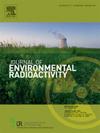在年度修订期间对瑞士压水反应堆周围大气中的 14CH4、14CO2 和 37Ar 进行测量
IF 1.9
3区 环境科学与生态学
Q3 ENVIRONMENTAL SCIENCES
引用次数: 0
摘要
自 20 世纪 80 年代以来,放射性碳(14C)作为量化大气中化石和非化石排放的二氧化碳和甲烷数量的重要工具备受关注。然而,自 20 世纪 70 年代以来,由于核电站的运行,大气中也出现了重要的 14C 排放。由于对这些排放的了解有限,将 14C 用作通用的排放源分配工具面临挑战。根据反应堆类型的不同,14C 的排放形式也不同;特别是,压水反应堆以 14CH4 和 14CO2 的混合物形式排放 14C。然而,在核电厂附近进行的大气 14C 测量很少,这些测量主要针对 14CO2 排放。核反应堆中也会产生氩-37(37Ar),但其大气测量具有挑战性,因此可用数据有限。在本研究中,我们在 2019 年年度修订期开始时,即 14C 和 37Ar 排放预计会因反应堆减压而开始时,在 20-75 分钟内对瑞士戈斯根压水反应堆周围的 18 个独立袋中的环境空气进行了采样。这些样本分析了 14CH4、14CO2 和部分 37Ar。在烟囱下风向约 1 公里处,我们发现经本底校正的放射性活度分别高达 1900、370 和 93 mBq m-3。考虑到 14CH4、14CO2 和 37Ar 的相应本底放射性活度分别为 0.3、48 和 2 mBq m-3,这分别代表了约 6300、7.4 和 47 倍的过量。利用大气扩散模型,我们令人满意地模拟了这次事件中反应堆周围的 14CH4 和 14CO2 活动。我们的测量结果强调了核电站在解释大气 14C 测量结果方面的重要性,并表明压水反应堆在使用 14C 进行 CH4 来源划分方面存在严重的局限性。我们的结果还让人们了解到民用 37Ar 排放的大致规模,特别是在维护操作期间。本文章由计算机程序翻译,如有差异,请以英文原文为准。
Atmospheric 14CH4, 14CO2 and 37Ar measurements around a Swiss pressurized water reactor during an annual revision period
Since the 1980s, radiocarbon (14C) has gained attention as a valuable tool to quantify the amount of fossil and non-fossil emissions of CO2 and CH4 in the atmosphere. Since the 1970s, however, important 14C emissions in the atmosphere also occur through the operation of nuclear power plants. The limited knowledge about these emissions challenges the use of 14C as a universal source apportionment tool. Depending on the reactor type, 14C is emitted in different forms; in particular, pressurized water reactors emit 14C as a mixture of 14CH4 and 14CO2. However, few atmospheric 14C measurements close to nuclear power plants are available, which mostly address 14CO2 emissions. Argon-37 (37Ar) can also be produced in nuclear reactors; however, its atmospheric measurement is challenging, resulting in limited available data. In this study, we sampled ambient air during 20–75 min into 18 individual bags around the pressurized water reactor in Gösgen, Switzerland, at the beginning of the annual revision period in 2019, when 14C and 37Ar emissions can be expected due to the depressurization of the reactor. These samples were analyzed for 14CH4, 14CO2 and partly for 37Ar. About 1 km downwind of the stack, we found background-corrected activities up to 1900, 370, and 93 mBq m−3 respectively. Considering corresponding background activities of 0.3, 48 and 2 mBq m−3 for 14CH4, 14CO2, and 37Ar, this represents an excess of about 6300, 7.4, and 47 times, respectively. Using an atmospheric dispersion model, we satisfactorily simulated the 14CH4 and 14CO2 activities in the surroundings of the reactor during this event. Our measurements emphasize the importance of nuclear power plants in the interpretation of atmospheric 14C measurements and show that pressurized water reactors represent a serious limitation in the use of 14C for source apportionment of CH4 sources. Our results also provide insights into the approximate magnitude of civilian 37Ar emissions from nuclear facilities specifically during maintenance operations.
求助全文
通过发布文献求助,成功后即可免费获取论文全文。
去求助
来源期刊

Journal of environmental radioactivity
环境科学-环境科学
CiteScore
4.70
自引率
13.00%
发文量
209
审稿时长
73 days
期刊介绍:
The Journal of Environmental Radioactivity provides a coherent international forum for publication of original research or review papers on any aspect of the occurrence of radioactivity in natural systems.
Relevant subject areas range from applications of environmental radionuclides as mechanistic or timescale tracers of natural processes to assessments of the radioecological or radiological effects of ambient radioactivity. Papers deal with naturally occurring nuclides or with those created and released by man through nuclear weapons manufacture and testing, energy production, fuel-cycle technology, etc. Reports on radioactivity in the oceans, sediments, rivers, lakes, groundwaters, soils, atmosphere and all divisions of the biosphere are welcomed, but these should not simply be of a monitoring nature unless the data are particularly innovative.
 求助内容:
求助内容: 应助结果提醒方式:
应助结果提醒方式:


